New Transition Metal Coordination Polymers Derived from 2-(3,5-Dicarboxyphenyl)-6-carboxybenzimidazole as Photocatalysts for Dye and Antibiotic Decomposition
Abstract
:1. Introduction
2. Results and Discussion
2.1. Structural Description of 1[Ni(HL)(H2O)2·1.9H2O]
2.2. Structural Description of 2
2.3. Structural Description of 3
2.4. FTIR Spectroscopy, Thermogravimetric Analyses, PXRD, and BET Surface Area Analysis
2.5. Photocatalytic Applications
3. Conclusions
4. Experimental
4.1. Materials and Method
4.2. Syntheses
4.2.1. Synthesis of 1
4.2.2. Synthesis of 2
4.2.3. Synthesis of 3
4.3. X-ray Crystallography
4.4. Photocatalytic Method
4.5. Computational Details
Supplementary Materials
Author Contributions
Funding
Institutional Review Board Statement
Informed Consent Statement
Data Availability Statement
Acknowledgments
Conflicts of Interest
Sample Availability
References
- He, X.; Wu, M.; Ao, Z.; Lai, B.; Zhou, Y.; An, T.; Wang, S. Metal–organic frameworks derived C/TiO2 for visible light photocatalysis: Simple synthesis and contribution of carbon species. J. Hazard. Mater. 2020, 403, 124048. [Google Scholar] [CrossRef] [PubMed]
- Ryoji, A.; Takeshi, M.; Hiroshi, I.; Takeshi, O. Nitrogen-Doped Titanium Dioxide as Visible-Light-Sensitive Photocatalyst: Designs, Developments, and Prospects. Chem. Rev. 2014, 114, 9824–9852. [Google Scholar]
- Zhang, H.; Chen, G.; Bahnemann, D.W. Photoelectrocatalytic materials for environmental applications. J. Mater. Chem. 2009, 19, 5089–5121. [Google Scholar] [CrossRef]
- Kaur, S.; Sharma, S.; Kansal, S.K. Synthesis of ZnS/CQDs nanocomposite and its application as a photocatalyst for the degradation of an anionic dye, ARS. Superlattices Microstruct. 2016, 98, 86–95. [Google Scholar] [CrossRef]
- Zhang, J.; Liu, H.; Ma, Z. Flower-like Ag2O/Bi2MoO6 p-n heterojunction with enhanced photocatalytic activity under visible light irradiation. J. Mol. Catal. A Chem. 2016, 424, 37–44. [Google Scholar] [CrossRef]
- Wang, B.; Feng, W.; Zhang, L.; Zhang, Y.; Huang, X.; Fang, Z.; Liu, P. In situ construction of a novel Bi/CdS nanocomposite with enhanced visible light photocatalytic performance. Appl. Catal. B Environ. 2017, 206, 510–519. [Google Scholar] [CrossRef]
- Ding, Y.; Zhang, X.; Zhang, N.; Zhang, J.; Zhang, R.; Liu, Y.; Fang, Y. A visible-light driven Bi2S3@ ZIF-8 core–shell heterostructure and synergistic photocatalysis mechanism. Dalton Trans. 2018, 47, 684–692. [Google Scholar] [CrossRef]
- Li, M.; Li, D.; O’keeffe, M.; Yaghi, O.M. Topological Analysis of Metal–Organic Frameworks with Polytopic Linkers and/or Multiple Building Units and the Minimal Transitivity Principle. Chem. Rev. 2013, 114, 1343–1370. [Google Scholar] [CrossRef]
- Huang, L.; Liu, B. Synthesis of a novel and stable reduced graphene oxide/MOF hybrid nanocomposite and photocatalytic performance for the degradation of dyes. RSC Adv. 2016, 6, 17873–17879. [Google Scholar] [CrossRef]
- Zhang, N.; Yang, M.-Q.; Liu, S.; Sun, Y.; Xu, Y.-J. Waltzing with the Versatile Platform of Graphene to Synthesize Composite Photocatalysts. Chem. Rev. 2015, 115, 10307–10377. [Google Scholar] [CrossRef]
- Zheng, M.; Chen, J.; Zhang, L.; Cheng, Y.; Lu, C.; Liu, Y.; Singh, A.; Trivedi, M.; Kumar, A.; Liu, J. Metal organic frameworks as efficient adsorbents for drugs from wastewater. Mater. Today Commun. 2022, 31, 103514. [Google Scholar] [CrossRef]
- Gómez, V.; Larrechi, M.; Callao, M. Kinetic and adsorption study of acid dye removal using activated carbon. Chemosphere 2007, 69, 1151–1158. [Google Scholar] [CrossRef] [PubMed]
- Wang, S.; Zhu, Z. Characterisation and environmental application of an Australian natural zeolite for basic dye removal from aqueous solution. J. Hazard. Mater. 2006, 136, 946–952. [Google Scholar] [CrossRef] [PubMed]
- Tahir, S.; Rauf, N. Removal of a cationic dye from aqueous solutions by adsorption onto bentonite clay. Chemosphere 2006, 63, 1842–1848. [Google Scholar] [CrossRef]
- Huang, J.; Cao, Y.; Shao, Q.; Peng, X.; Guo, Z. Magnetic Nanocarbon Adsorbents with Enhanced Hexavalent Chromium Removal: Morphology Dependence of Fibrillar vs. Particulate Structures. Ind. Eng. Chem. Res. 2017, 56, 10689–10701. [Google Scholar] [CrossRef]
- Wang, H.; Yuan, X.; Wu, Y.; Zeng, G.; Dong, H.; Chen, X.; Leng, L.; Wu, Z.; Peng, L. In situ synthesis of In2S3@MIL-125(Ti) core–shell microparticle for the removal of tetracycline from wastewater by integrated adsorption and visible-light-driven photocatalysis. Appl. Catal. B Environ. 2016, 186, 19–29. [Google Scholar] [CrossRef]
- Ma, D.Y.; Li, Z.; Zhu, J.X.; Zhou, Y.P.; Chen, L.L.; Mai, X.F.; Liufu, M.L.; Wu, Y.B.; Li, Y.W. Inverse and highly selective separation of CO2/C2H2 on a thulium–organic framework. J. Mater. Chem. A 2020, 8, 11933–11937. [Google Scholar] [CrossRef]
- Ke, F.; Pan, A.; Liu, J.; Liu, X.; Yuan, T.; Zhang, C.; Fu, G.; Peng, C.; Zhu, J.; Wan, X. Hierarchical camellia-like metal–organic frameworks via a bimetal competitive coordination combined with alkaline-assisted strategy for boosting selective fluoride removal from brick tea. J. Colloid Interface Sci. 2023, 642, 61–68. [Google Scholar] [CrossRef] [PubMed]
- Atsushi, K.; Hiroshi, K.; Hiroshi, N.; Lucia, C.; Davide, M.P.; Gianfranco, C.; Kenichi, K.; Masaki, T.; Hiroko, S.; Masami, S.; et al. Super flexibility of a 2D Cu-based porous coordination framework on gas adsorption in comparison with a 3D framework of identical composition: Framework dimensionality-dependent gas adsorptivities. J. Am. Chem. Soc. 2011, 133, 10512–10522. [Google Scholar]
- Liu, K.-G.; Rouhani, F.; Moghanni-Bavil-Olyaei, H.; Wei, X.-W.; Gao, X.-M.; Li, J.-Z.; Yan, X.-W.; Hu, M.-L.; Morsali, A. A conductive 1D high-nucleus silver polymer as a brilliant non-hybrid supercapacitor electrode. J. Mater. Chem. A 2020, 8, 12975–12983. [Google Scholar] [CrossRef]
- Sakhapov, I.F.; Zagidullin, A.A.; Dobrynin, A.B.; Litvinov, I.A.; Yakhvarov, D.G.; Bondarenko, M.A.; Novikov, A.S.; Fedin, V.P.; Adonin, S.A. Crystal Structures of 3, 3′, 5, 5′-Tetrabromo-4, 4′-bipyridine and Co(II) Coordination Polymer Based Thereon. Crystals 2023, 13, 704. [Google Scholar] [CrossRef]
- Zhao, X.; He, X.; Hou, A.; Cheng, C.; Wang, X.; Yue, Y.; Wu, Z.; Wu, H.; Liu, B.; Li, H.; et al. Growth of Cu2O nanoparticles on two-dimensional Zr–ferrocene–metal–organic framework nanosheets for photothermally enhanced chemodynamic antibacterial therapy. Inorg. Chem. 2022, 61, 9328–9338. [Google Scholar] [CrossRef] [PubMed]
- Hu, J.T.; Xu, Z.J.; Liao, D.H.; Jiang, Y.H.; Pu, H.J.; Wu, Z.Y.; Xu, X.T.; Zhao, Z.; Liu, J.Q.; Lu, X.W.; et al. An H2S-BMP6 Dual-Loading System with Regulating Yap/Taz and Jun Pathway for Synergistic Critical Limb Ischemia Salvaging Therap. Adv. Healthc. Mater. 2023, e2301316. [Google Scholar] [CrossRef] [PubMed]
- Wang, H.; Chen, Y.; Wang, H.; Liu, X.; Zhou, X.; Wang, F. DNAzyme-loaded metaleorganic frameworks (MOFs) for self-sufficient gene therapy. Angew. Chem. Int. Ed. 2019, 58, 7380–7384. [Google Scholar] [CrossRef] [PubMed]
- Hu, W.B.; Wang, S.Y.; Jiang, C.J.; Zheng, M.B.; Bai, Z.; Srivastava, D.; Kumar, A.; Liu, J.Q. Synthesis and characterized three Zn(II)-based mixed geometry coordination polymers and photocatalytic activity against dyes. Dye. Pigment. 2023, 219, 111596. [Google Scholar] [CrossRef]
- Qin, L.; Liang, F.; Li, Y.; Wu, J.; Guan, S.; Wu, M.; Xie, S.; Luo, M.; Ma, D. A 2D Porous Zinc-Organic Framework Platform for Loading of 5-Fluorouracil. Inorganics 2022, 10, 202. [Google Scholar] [CrossRef]
- Wang, L.; Zhi, W.; Lian, D.; Wang, Y.; Han, J.; Wang, Y. HRP@ZIF-8/DNA hybrids: Functionality integration of ZIF-8 via biomineralization and surface absorption. ACS Sustain. Chem. Eng. 2019, 7, 14611–14620. [Google Scholar] [CrossRef]
- Xu, Z.; Wu, Z.; Huang, S.; Ye, K.; Jiang, Y.; Liu, J.; Liu, J.; Lu, X.; Li, B. A metal-organic framework-based immunomodulatory nanoplatform for anti-atherosclerosis treatment. J. Control. Release 2023, 354, 615–625. [Google Scholar] [CrossRef]
- Zhong, Y.Y.; Peng, Z.X.; Peng, Y.Q.; Li, B.; Pan, Y.; Ouyang, Q.; Sakiyama, H.; Muddassir, M.; Liu, J.Q. Construction of Fe-doped ZIF-8/DOX nanocomposites for ferroptosis strategy in the treatment of breast cancer. J. Mater. Chem. B 2023, 11, 6335–6345. [Google Scholar] [CrossRef]
- Qin, J.-H.; Zhang, H.; Sun, P.; Huang, Y.-D.; Shen, Q.; Yang, X.-G.; Ma, L.-F. Ionic liquid induced highly dense assembly of porphyrin in MOF nanosheets for photodynamic therapy. Dalton Trans. 2020, 49, 17772–17778. [Google Scholar] [CrossRef]
- Feng, J.; Xu, Z.; Dong, P.; Yu, W.; Liu, F.; Jiang, Q.; Wang, F.; Liu, X. Stimuliresponsive multifunctional metaleorganic framework nanoparticles for enhanced chemo-photothermal therapy. J. Mater. Chem. B 2019, 7, 994–1004. [Google Scholar] [CrossRef] [PubMed]
- Shi, X.; Qu, X.; Chai, J.; Tong, C.; Fan, Y.; Wang, L. Stable coordination polymers with linear dependence color tuning and luminescent properties for detection of metal ions and explosives. Dye. Pigment. 2019, 170, 107583. [Google Scholar] [CrossRef]
- Zhang, X.-D.; Zhao, Y.; Chen, K.; Guo, J.-H.; Wang, P.; Wu, H.; Sun, W.-Y. Cucurbit[6]uril-based supramolecular assemblies incorporating metal complexes with multiaromatic ligands as structure-directing agent for detection of aromatic amines and nitroaromatic compounds. Sens. Actuators B Chem. 2018, 282, 844–853. [Google Scholar] [CrossRef]
- Qin, J.-H.; Qin, W.-J.; Xiao, Z.; Yang, J.-K.; Wang, H.-R.; Yang, X.-G.; Li, D.-S.; Ma, L.-F. Efficient energy-transfer-induced high photoelectric conversion in a dye-encapsulated ionic pyrene-based metal–organic framework. Inorg. Chem. 2021, 60, 18593–18597. [Google Scholar] [CrossRef] [PubMed]
- Binnemans, K. Lanthanide-based luminescent hybrid materials. Chem. Rev. 2009, 109, 4283–4374. [Google Scholar] [CrossRef]
- Jiang, Y.; Huang, Y.; Shi, X.; Lu, Z.; Ren, J.; Wang, Z.; Xu, J.; Fan, Y.; Wang, L. Eu-MOF and its mixed-matrix membranes as a fluorescent sensor for quantitative ratiometric pH and folic acid detection, and visible fingerprint identifying. Inorg. Chem. Front. 2021, 8, 4924–4932. [Google Scholar] [CrossRef]
- Wang, S.; Ouyang, L.; Deng, G.; Deng, Z.; Wang, S. DNA adsorption on nanoscale zeolitic imidazolate framework-8 enabling rational design of a DNA-based nanoprobe for gene detection and regulation in living cells. RSC Adv. 2020, 10, 31012–31021. [Google Scholar] [CrossRef]
- Feng, X.; Li, J.; Feng, Y.; Zhang, K.; Chen, N.; Fang, H.; Li, Z. Series of d10 complexes based on sulfamethoxazole: Auxiliary ligand induces structure diversity, luminescence and antibacterial properties. J. Solid State Chem. 2021, 302, 122351. [Google Scholar] [CrossRef]
- Feng, X.; Feng, Y.Q.; Chen, J.J.; Wang, L.Y.; Guo, J.Z. Reticular three-dimensional 3d–4f frameworks constructed through substituted imidazole-dicarboxylate: Syntheses, luminescence and magnetic properties study. Dalton Trans. 2015, 44, 804–816. [Google Scholar] [CrossRef]
- Hu, M.-L.; Joharian, M.; Razavi, S.A.A.; Morsali, A.; Wu, D.-Z.; Tehrani, A.A.; Wang, J.; Junk, P.C.; Guo, Z.-F. Phenolic nitroaromatics detection by fluorinated metal-organic frameworks: Barrier elimination for selective sensing of specific group of nitroaromatics. J. Hazard. Mater. 2020, 406, 124501. [Google Scholar] [CrossRef]
- Qin, J.-H.; Zhang, J.-R.; Xiao, Z.; Wu, Y.-P.; Xu, H.-M.; Yang, X.-G.; Ma, L.-F.; Li, D.-S. Topology- and Guest-Dependent Photoelectric Conversion of 2D Anionic Pyrene-Based Metal–Organic Framework. Cryst. Growth Des. 2022, 22, 4018–4024. [Google Scholar] [CrossRef]
- Li, G.; Wang, T.; Zhou, S.; Wang, J.; Lv, H.; Han, M.; Singh, D.P.; Kumar, A.; Jin, J. New highly luminescent 3D Tb(III)-MOF as selective sensor for antibiotics. Inorg. Chem. Commun. 2021, 130, 108756. [Google Scholar] [CrossRef]
- Llabrés i Xamena, F.X.; Corma, A.; Garcia, H. Applications for metal-organic frameworks (MOFs) as quantum dot semiconductors. J. Phys. Chem. C 2007, 111, 80–85. [Google Scholar] [CrossRef]
- Sun, Z.; Wu, X.; Qu, K.; Huang, Z.; Liu, S.; Dong, M.; Guo, Z. Bimetallic metal-organic frameworks anchored corncob-derived porous carbon photocatalysts for synergistic degradation of organic pollutants. Chemosphere 2020, 259, 127389. [Google Scholar] [CrossRef] [PubMed]
- Aguilera-Sigalat, J.; Bradshaw, D. Synthesis and applications of metal-organic framework–quantum dot (QD@MOF) composites. Co-ord. Chem. Rev. 2016, 307, 267–291. [Google Scholar] [CrossRef]
- Jin, J.-C.; Yang, M.; Zhang, Y.-L.; Dutta, A.; Xie, C.-G.; Kumar, A. Integration of mixed ligand into a multivariate metal-organic framework for enhanced UV-light photocatalytic degradation of Rhodamine B. J. Taiwan Inst. Chem. Eng. 2021, 129, 410–417. [Google Scholar] [CrossRef]
- Zhuang, J.; Kuo, C.H.; Chou, L.Y.; Liu, D.Y.; Weerapana, E.; Tsung, C.K. Optimized Metal-organic framework nanospheres for drug delivery: Evaluation of small-molecule encapsulation. ACS Nano 2014, 8, 2812–2819. [Google Scholar] [CrossRef]
- Liu, J.-Q.; Lin, Z.; Liao, D.; Jiang, C.; Song, H.; Nezamzadeh-Ejhieh, A.; Zheng, M.; Yuan, H.; Lu, C. Current status and prospect of MIL-based MOF materials for biomedicine applications. RSC Med. Chem. 2023, 14, 1914–1933. [Google Scholar]
- Zhang, X.; Zhang, W.; Xiang, R.; Lan, L.; Dong, X.; Sakiyama, H.; Muddassir, M. Auxiliary linkers-induced assembly of two 2D Co(II)-based coordination polymers with different interpenetrating fashion: Structure and magnetism. Polyhedron 2023, 244, 116625. [Google Scholar] [CrossRef]
- Rao, C.; Zhou, L.; Pan, Y.; Lu, C.; Qin, X.; Sakiyama, H.; Muddassir, M.; Liu, J. The extra-large calixarene-based MOFs-derived hierarchical composites for photocatalysis of dye: Facile syntheses and contribution of carbon species. J. Alloy. Compd. 2021, 897, 163178. [Google Scholar] [CrossRef]
- Wang, Y.F.; Wang, C.J.; Feng, Q.Z.; Zhai, J.J.; Qi, S.S.; Zhong, A.G.; Chu, M.M.; Xu, D.Q. Copper-catalyzed asymmetric 1, 6-conjugate addition of in situ generated para-quinone methides with β-ketoesters. Chem. Commun. 2022, 58, 6653–6656. [Google Scholar] [CrossRef] [PubMed]
- Yao, W.; Wang, J.; Lou, Y.; Wu, H.; Qi, X.; Yang, J.; Zhong, A. Chemoselective hydroborative reduction of nitro motifs using a transition-metal-free catalyst. Org. Chem. Front. 2021, 8, 4554–4559. [Google Scholar] [CrossRef]
- Wang, L.-H.; Chen, X.-J.; Ye, D.-N.; Liu, H.; Chen, Y.; Zhong, A.-G.; Li, C.-Z.; Liu, S.-Y. Pot- and atom-economic synthesis of oligomeric non-fullerene acceptors via C–H direct arylation. Polym. Chem. 2022, 13, 2351–2361. [Google Scholar] [CrossRef]
- Wang, D.; Jia, F.; Wang, H.; Chen, F.; Fang, Y.; Dong, W.; Zeng, G.; Li, X.; Yang, Q.; Yuan, X. Simultaneously efficient adsorption and photocatalytic degradation of tetracycline by Fe-based MOFs. J. Colloid Interface Sci. 2018, 519, 273–284. [Google Scholar] [CrossRef] [PubMed]
- Qin, T.; Zhang, X.; Li, D.; Dong, X.; Qi, N.; Shang, Y.; Sakiyamad, H.; Afzal, M.; Alarifi, A. Temperature modulation on functional coordination polymers with tetracarboxylate linker: Syntheses, structural traits, and magnetism. J. Mol. Struct. 2023, 1291, 136074. [Google Scholar] [CrossRef]
- Zhao, J.; Dang, Z.; Muddassir, M.; Raza, S.; Zhong, A.; Wang, X.; Jin, J. A New Cd(II)-Based Coordination Polymer for Efficient Photocatalytic Removal of Organic Dyes. Molecules 2023, 28, 6848. [Google Scholar] [CrossRef] [PubMed]
- Ma, A.; Wu, J.; Han, Y.; Li, B.; Cai, S.; Huang, H.; Singh, A.; Kumar, A.; Liu, J. Rational synthesis of a luminescent uncommon (3, 4, 6)-c connected Zn (II) MOF: A dual channel sensor for the detection of nitroaromatics and ferric ions. Dalton Trans. 2018, 47, 9627–9633. [Google Scholar] [CrossRef]
- Jin, J.-C.; Wu, J.; Liu, W.-C.; Ma, A.-Q.; Liu, J.-Q.; Singh, A.; Kumar, A. A new Zn(ii) metal–organic framework having 3D CdSO4 topology as luminescent sensor and photocatalyst for degradation of organic dyes. New J. Chem. 2018, 42, 2767–2775. [Google Scholar] [CrossRef]
- Jin, J.-C.; Wu, J.; He, Y.-X.; Li, B.-H.; Liu, J.-Q.; Prasad, R.; Kumar, A.; Batten, S.R. A 3D luminescent Zn(ii) MOF for the detection of high explosives and the degradation of organic dyes: An experimental and computational study. CrystEngComm 2017, 19, 6464–6472. [Google Scholar] [CrossRef]
- Zhang, X.Y.; Qin, T.R.; Xiang, R.F.; Dong, X.Y.; Muddassir, H.S.M.; Pan, Y. Impact of N-donor auxiliary ligands on three new Co(II)-based coordination polymers with symmetrical tetracarboxylate ligands: Magnetism study. New J. Chem. 2023, 46, 11623–11631. [Google Scholar]
- Gu, J.Z.; Cai, Y.; Wen, M.; Shi, Z.F.; Alexander, M.K. A new series of Cd (II) metal–organic architectures driven by soft ether-bridged tricarboxylate spacers: Synthesis, structural and topological versatility, and photocatalytic properties. Dalton Trans. 2018, 47, 14327–14339. [Google Scholar] [CrossRef] [PubMed]
- Zhang, X.Y.; Qin, T.R.; Xiang, R.F.; Dong, X.Y.; Muddassir, H.S.M.; Afzal, M.; Alarifi, A. Structures and magnetic studies of four new Ni(II) coordination polymers built by symmetrical tetracarboxylate and N-donor linkers. New J. Chem. 2023. [Google Scholar] [CrossRef]
- Gu, J.-Z.; Liang, X.-X.; Cai, Y.; Wu, J.; Shi, Z.-F.; Kirillov, A.M. Hydrothermal assembly, structures, topologies, luminescence, and magnetism of a novel series of coordination polymers driven by a trifunctional nicotinic acid building block. Dalton Trans. 2017, 46, 10908–10925. [Google Scholar] [CrossRef] [PubMed]
- Liu, E.E.; Gang, C.; Zeller, M.; Fabini, D.H.; Oertel, C.M. Ligand-Induced Variations in Symmetry and Structural Dimensionality of Lead Oxide Carboxylates. Cryst. Growth Des. 2017, 17, 1574–1582. [Google Scholar] [CrossRef]
- Wang, J.; Zhong, Y.; Bai, C.; Guan, Y.; Pan, Y.; Hu, H.-M. Series of coordination polymers with multifunctional properties for nitroaromatic compounds and CuII sensing. J. Solid State Chem. 2020, 288, 121381. [Google Scholar] [CrossRef]
- Biçer, F.A.; Yeşilel, O.Z. Synthesis, Characterization and the Effect of the Auxiliary Ligands on the Dimensionality of Two Cobalt(II)-Fumarate Coordination Polymers with Bis(Imidazole) Ligands. J. Struct. Chem. 2023, 64, 1423–1434. [Google Scholar] [CrossRef]
- Wang, Z.; Cohen, S.M. Postsynthetic modification of metal–organic frameworks. Chem. Soc. Rev. 2009, 38, 1315–1329. [Google Scholar] [CrossRef]
- Li, J.-R.; Kuppler, R.J.; Zhou, H.-C. Selective gas adsorption and separation in metal–organic frameworks. Chem. Soc. Rev. 2009, 38, 1477–1504. [Google Scholar] [CrossRef]
- Lee, J.; Farha, O.K.; Roberts, J.; Scheidt, K.A.; Nguyen, S.T.; Hupp, J.T. Metal–organic framework materials as catalysts. Chem. Soc. Rev. 2009, 38, 1450–1459. [Google Scholar] [CrossRef]
- Ding, J.; Yang, Z.; He, C.; Tong, X.; Li, Y.; Niu, X.; Zhang, H. UiO-66(Zr) coupled with Bi2MoO6 as photocatalyst for visible-light promoted dye degradation. J. Colloid Interface Sci. 2017, 497, 126–133. [Google Scholar] [CrossRef]
- Brechin, E.K.; Gould, R.O.; Harris, S.G.; Parsons, S.; Winpenny, R.E.P. Four cubes and an octahedron: A nickel-sodium supracage assembly. J. Am. Chem. Soc. 1996, 118, 11293–11294. [Google Scholar] [CrossRef]
- Zaguzin, A.S.; Mahmoudi, G.; Zubkov, F.I.; Bondarenko, M.A.; Zherebtsov, D.A.; Val’chuk, K.S.; Abramov, P.A.; Fedin, V.P.; Adonin, S.A. Heteroligand Zn (II) Metal-Organic Frameworks Based on 4-Substituted 4, 2′: 6′, 4″-Terpyridine Derivatives and Terephthalates. Russ. J. Coord. Chem. 2023, 49, 414–419. [Google Scholar] [CrossRef]
- Lin, C.-L.; Chen, Y.-F.; Qiu, L.-J.; Zhu, B.; Wang, X.; Luo, S.-P.; Shi, W.; Yang, T.-H.; Lei, W. Synthesis, structure and photocatalytic properties of coordination polymers based on pyrazole carboxylic acid ligands. CrystEngComm 2020, 22, 6847–6855. [Google Scholar] [CrossRef]
- Chen, J.; Li, Y.; Gu, J.; Kirillova, M.V.; Kirillov, A.M. Introducing a flexible tetracarboxylic acid linker into functional coordination polymers: Synthesis, structural traits, and photocatalytic dye degradation. New J. Chem. 2020, 44, 16082–16091. [Google Scholar] [CrossRef]
- Yunxia, Y.; Shiying, X.; Haixia, Z.; Huihui, N.; Wenjing, D.; Xiangxiang, W. Synthesis, structure, and properties of complexes based on 3, 5-di-(Triazole-1-yl)-Benzoic acid ligands. J. Solid State Chem. 2020, 284, 121180. [Google Scholar] [CrossRef]
- Wei, X.-J.; Liu, D.; Li, Y.-H.; Cui, G.-H. New 2D and 3D Cd(II) coordination polymers from aromatic dicarboxylate and 1,3-bis(5,6-dimethylbenzimidazol-1-yl)-2-propanol ligands: Syntheses, structures, photocatalytic, and luminescence sensing properties. J. Sol. State Chem. 2019, 272, 138–147. [Google Scholar] [CrossRef]
- Shen, L.; Liang, S.; Wu, W.; Liang, R.; Wu, L. Multifunctional NH2-mediated zirconium metal–organic framework as an efficient visible-light-driven photocatalyst for selective oxidation of alcohols and reduction of aqueous Cr(vi). Dalton Trans. 2013, 42, 13649–13657. [Google Scholar] [CrossRef] [PubMed]
- Mu, B.; Li, C.X.; Song, M.; Ren, Y.L.; Huang, R.D. The electrochemical properties, nitrogen adsorption, and photocatalytic activities of three 3D metal–organic frameworks bearing the rigid terphenyl tetracarboxylates ligands. CrystEngComm 2016, 18, 3086–3094. [Google Scholar] [CrossRef]
- Wang, Z.X.; Tian, H.X.; Ding, J.G.; Li, B.L.; Wu, B. A Co-MOF with a (4,4)-connected binodal two-dimensional topology: Synthesis, structure and photocatalytic properties. Acta Crystallogr C Struct Chem. 2020, 76, 23–29. [Google Scholar] [CrossRef]
- Yang, H.; Liu, T.; Cao, M.; Li, H.; Gao, S.; Cao, R. A water-insoluble and visible light induced polyoxometalate-based photocatalyst. Chem. Commun. 2010, 46, 2429–2431. [Google Scholar] [CrossRef]
- Meng, J.-X.; Lu, Y.; Li, Y.-G.; Fu, H.; Wang, E.-B. Controllable self-assembly of four new metal–organic frameworks based on different phosphomolybdate clusters by altering the molar ratio of H3PO4 and Na2MoO4. CrystEngComm 2011, 13, 2479–2486. [Google Scholar] [CrossRef]
- Guo, J.; Yang, J.; Liu, Y.Y.; Ma, J.F. Two novel 3D metal–organic frameworks based on two tetrahedral ligands: Syntheses, structures, photoluminescence and photocatalytic properties. CrystEngComm 2012, 14, 6609–6617. [Google Scholar] [CrossRef]
- Zhu, S.-R.; Liu, P.-F.; Wu, M.-K.; Zhao, W.-N.; Li, G.-C.; Tao, K.; Yi, F.-Y.; Han, L. Enhanced photocatalytic performance of BiOBr/NH2-MIL-125(Ti) composite for dye degradation under visible light. Dalton Trans. 2016, 45, 17521–17529. [Google Scholar] [CrossRef] [PubMed]
- Luo, C.; He, X.; Zhong, A.; Liu, S.; Zhao, D. What dictates alkane isomerization? A combined density functional theory and information-theoretic approach study. Theor. Chem. Accounts 2023, 142, 78. [Google Scholar] [CrossRef]
- Cao, X.; Rong, C.; Zhong, A.; Lu, T.; Liu, S. Molecular acidity: An accurate description with information-theoretic approach in density functional reactivity theory. J. Comput. Chem. 2017, 39, 117–129. [Google Scholar] [CrossRef] [PubMed]
- Liu, L.; Ding, J.; Huang, C.; Li, M.; Hou, H.; Fan, Y. Polynuclear CdII Polymers: Crystal Structures, Topologies, and the Photodegradation for Organic Dye Contaminants. Cryst. Growth Des. 2014, 14, 3035–3043. [Google Scholar] [CrossRef]
- Wen, L.; Zhao, J.; Lv, K.; Wu, Y.; Deng, K.; Leng, X.; Li, D. Visible-Light-Driven Photocatalysts of Metal–Organic Frameworks Derived from Multi-Carboxylic Acid and Imidazole-Based Spacer. Cryst. Growth Des. 2012, 12, 1603–1612. [Google Scholar] [CrossRef]
- Hao, J.M.; Yu, B.Y.; Hecke, K.V.; Cui, G.H. A series of d 10 metal coordination polymers based on a flexible bis (2-methylbenzimidazole) ligand and different carboxylates: Synthesis, structures, photoluminescence and catalytic properties. CrystEngComm 2015, 17, 2279–2293. [Google Scholar] [CrossRef]
- Yeber, M.C.; Díaz, L.; Fernández, J. Catalytic activity of the SO4−radical for photodegradation of the azo dye Cibacron Brilliant Yellow 3 and 3, 4-dichlorophenol: Optimization by application of response surface methodology. J. Photochem. Photobiol. A 2010, 215, 90–95. [Google Scholar] [CrossRef]
- Cui, J.W.; An, W.J.; Van Hecke, K.; Cui, G.H. Two copper (I) cyanide coordination polymers modified by semi rigid bis (benzimidazole) ligands: Syntheses, crystal structures, and electrochemical and photocatalytic properties. Dalton Trans. 2016, 45, 17474–17484. [Google Scholar] [CrossRef]
- Zeng, L.; Guo, X.; He, C.; Duan, C. Metal–Organic Frameworks: Versatile Materials for Heterogeneous Photocatalysis. ACS Catal. 2016, 6, 7935–7947. [Google Scholar] [CrossRef]
- Hao, S.Y.; Hou, S.X.; Van Hecke, K.; Cui, G.H. Construction of noninterpenetrating and interpenetrating Co (II) networks with halogenated carboxylate modulated by auxiliary N-donor co-ligands: Structural diversity, electrochemical and photocatalytic properties. Dalton Trans. 2017, 46, 1951–1964. [Google Scholar] [CrossRef]
- Turner, M.J.; McKinnon, J.J.; Jayatilaka, D.; Spackman, M.A. Visualisation and characterisation of voids in crystalline materials. CrystEngComm 2011, 13, 1804–1813. [Google Scholar] [CrossRef]
- Wolff, S.K.; Grimwood, D.J.; McKinnon, J.J.; Turner, M.J.; Jayatilaka, D.; Spackman, M.A. Crystal Explorer, Version 3.1; University of Western Australia: Perth, Australia, 2012. [Google Scholar]
- Wang, K.; He, X.; Rong, C.; Zhong, A.; Liu, S.; Zhao, D. On the origin and nature of internal methyl rotation barriers: An information-theoretic approach study. Theor. Chem. Accounts 2022, 141, 68. [Google Scholar] [CrossRef]
- Sheldrick, G.M. SHELXT—integrated space-group and crystal-structure determination. Acta Crystallogr. Sect. A Found Adv. 2015, 71, 3–8. [Google Scholar] [CrossRef] [PubMed]
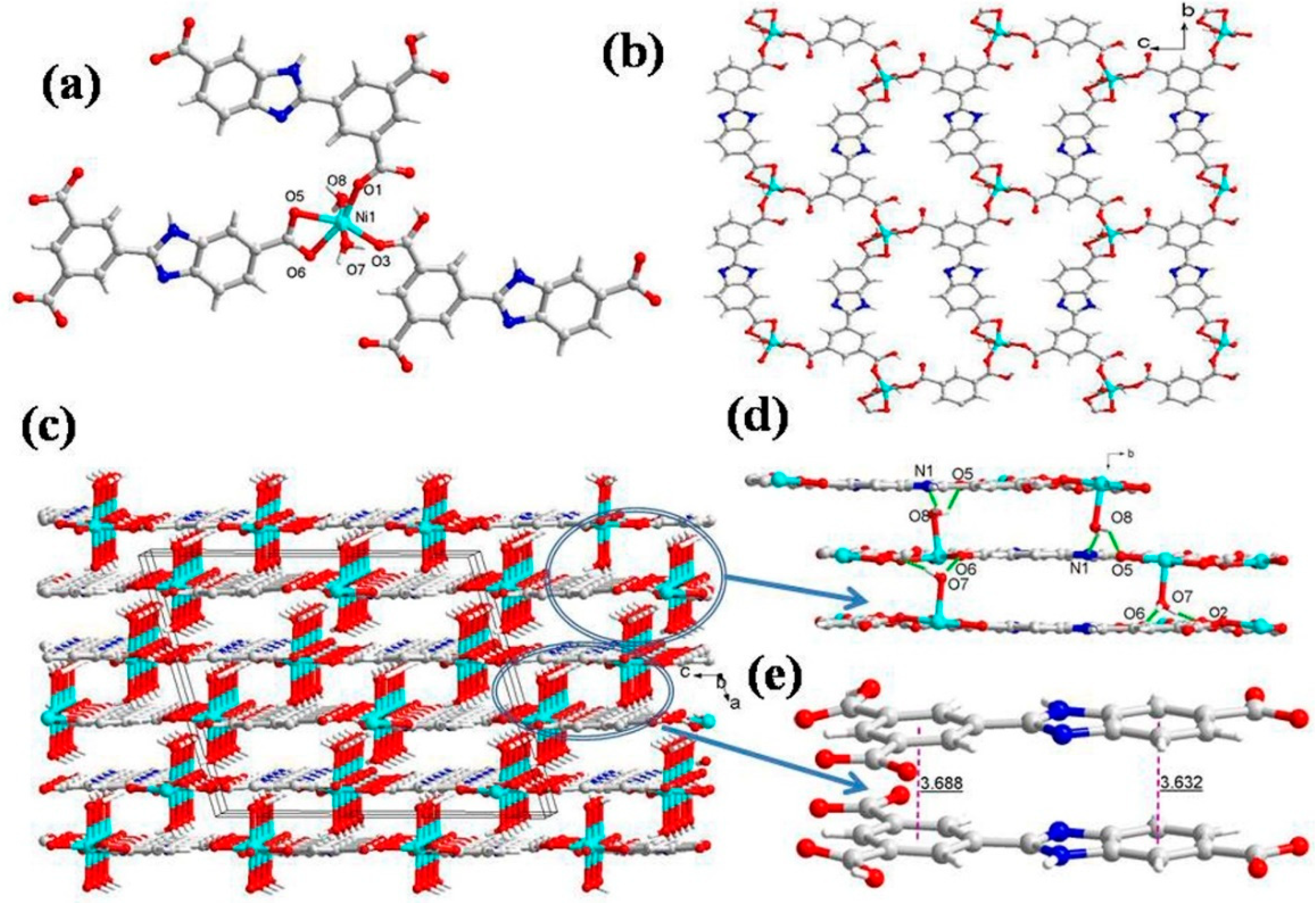

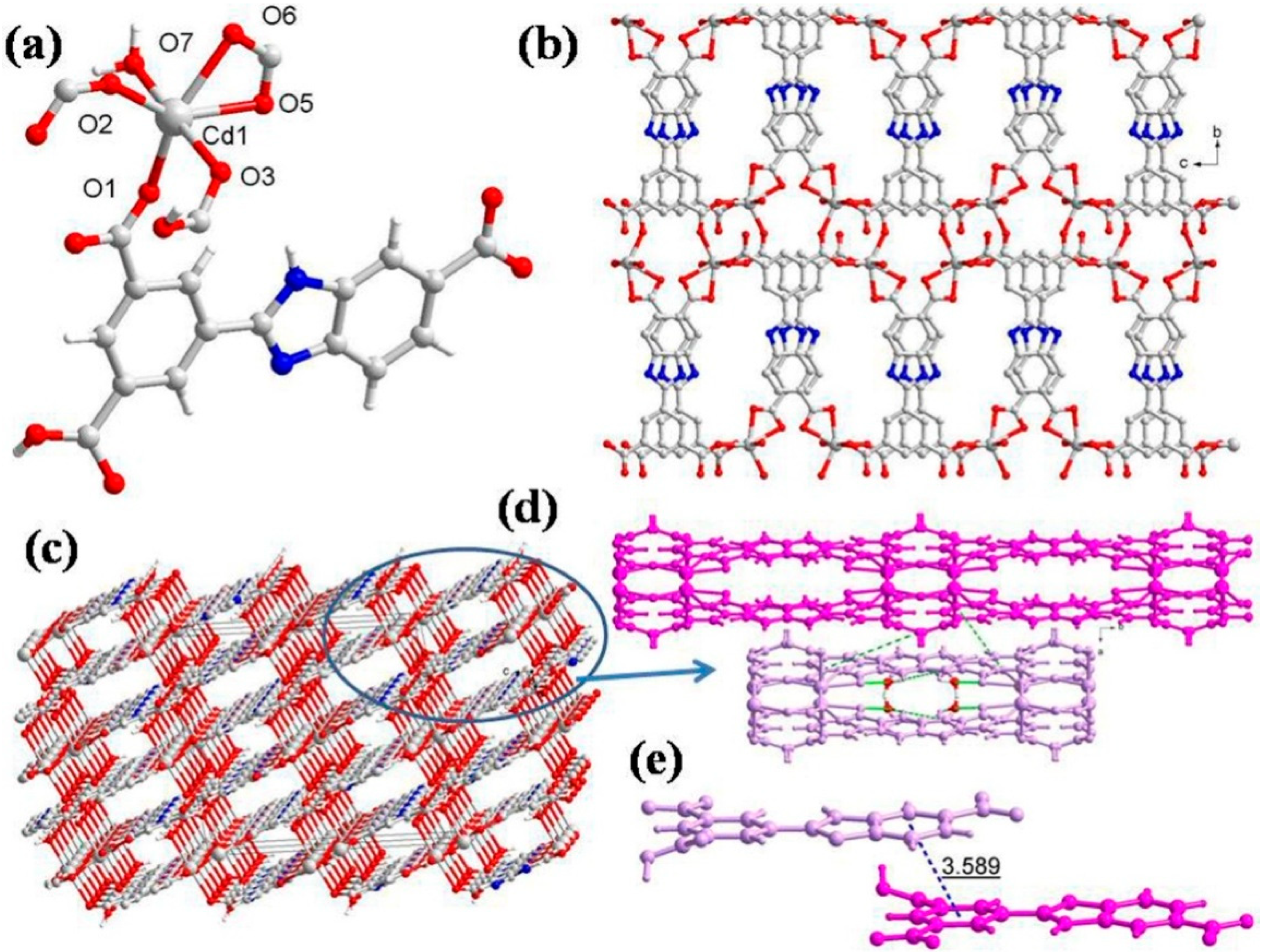

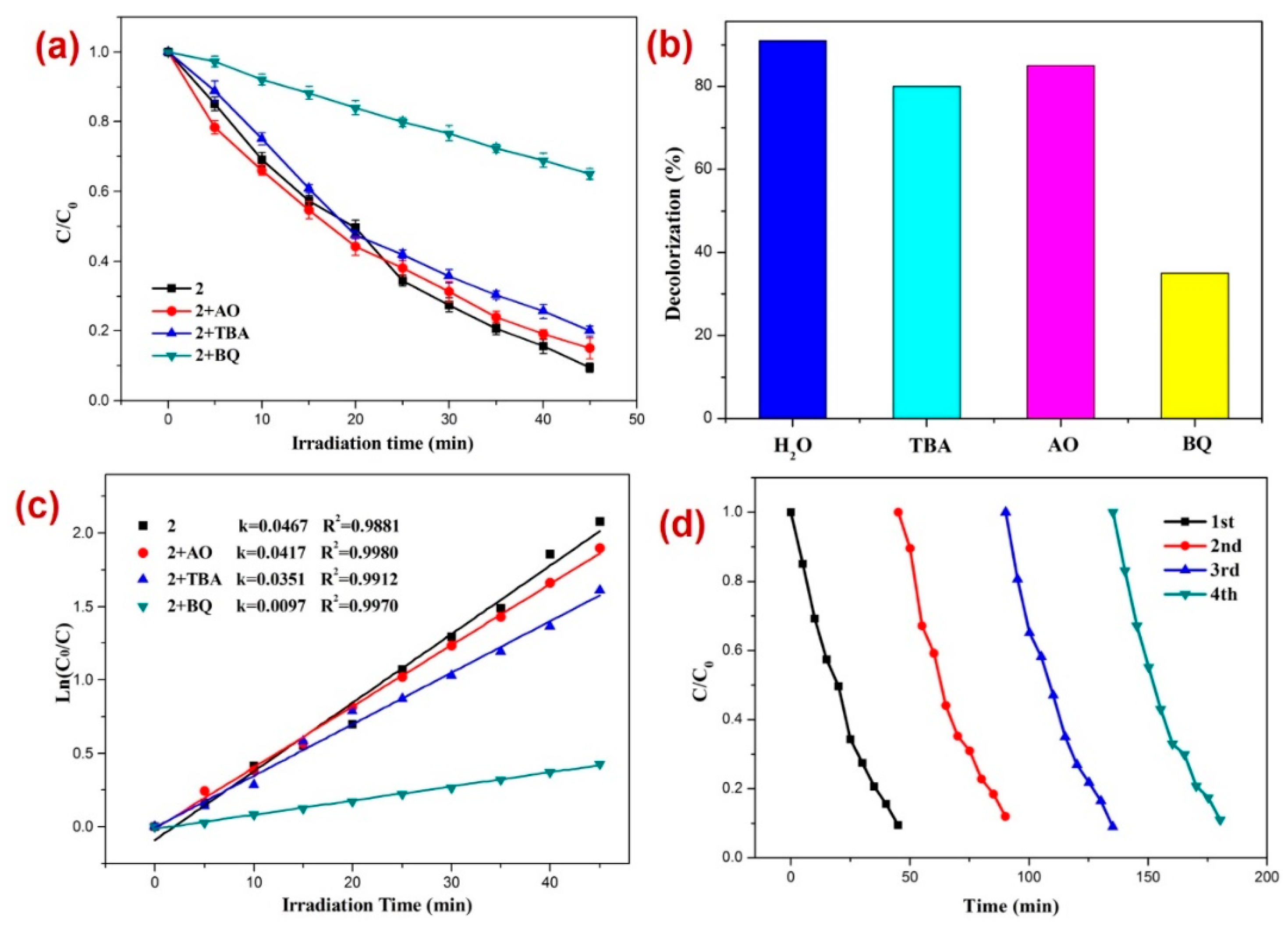
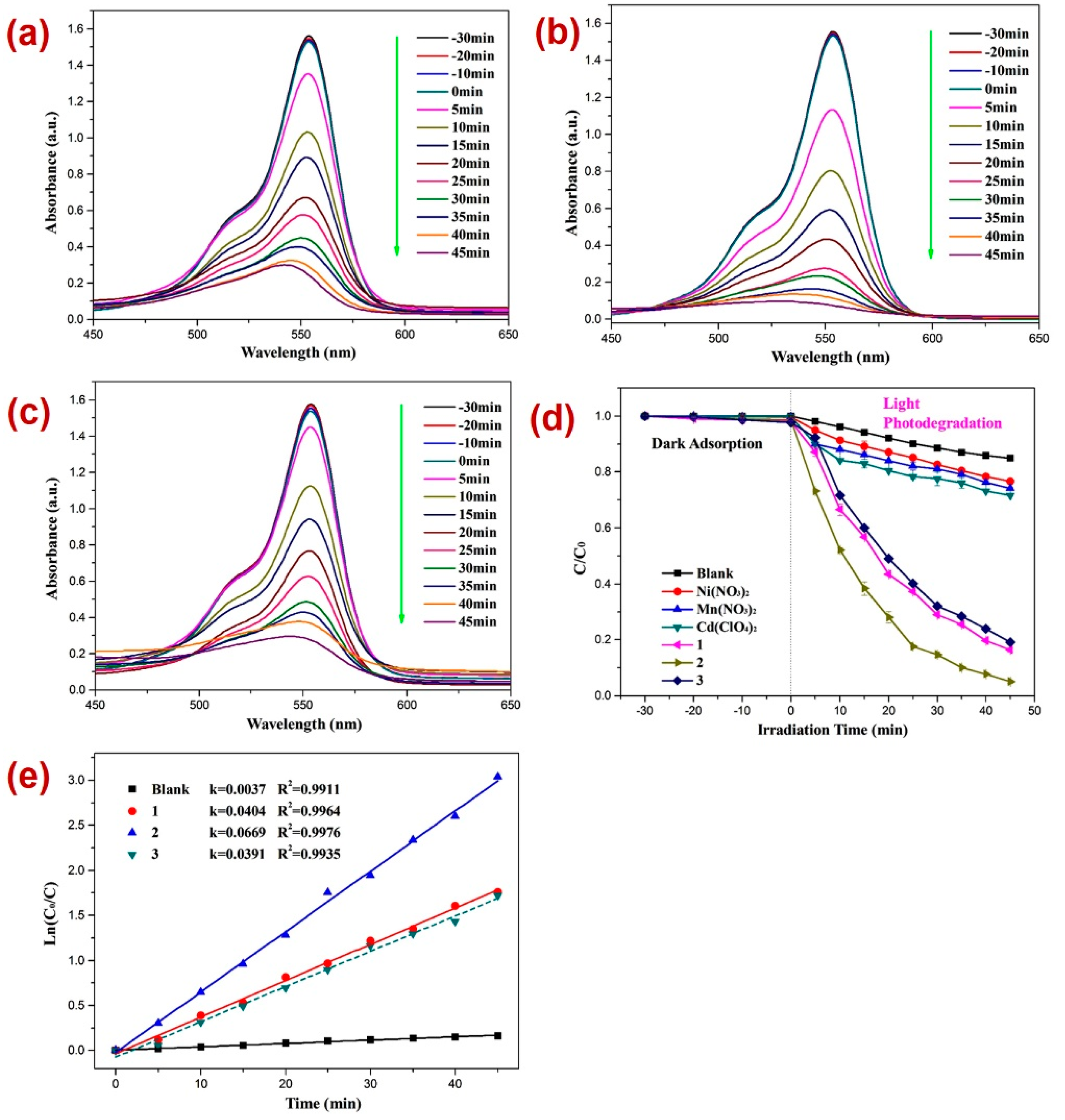



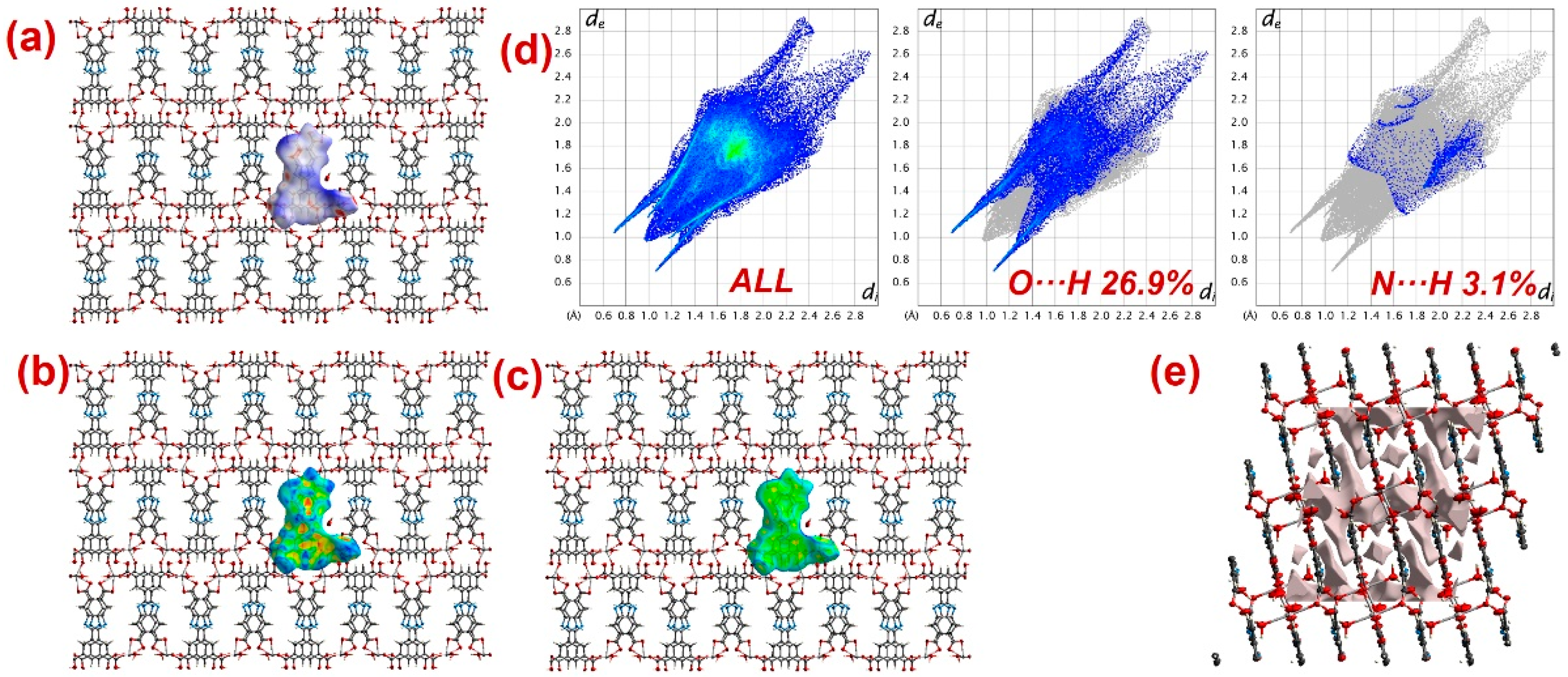
| Material | DTZ | RhB | ||
|---|---|---|---|---|
| k (min−1) | R2 | k (min−1) | R2 | |
| Blank | 0.0037 | 0.9931 | 0.0037 | 0.9911 |
| 1 | 0.0443 | 0.9971 | 0.0404 | 0.9964 |
| 2 | 0.0467 | 0.9881 | 0.0669 | 0.9976 |
| 3 | 0.0296 | 0.9914 | 0.0391 | 0.9935 |
| 2 + AO | 0.0417 | 0.9980 | 0.0350 | 0.9966 |
| 2 + TBA | 0.0351 | 0.9912 | 0.0413 | 0.9974 |
| 2 + BQ | 0.0097 | 0.9970 | 0.0078 | 0.9970 |
Disclaimer/Publisher’s Note: The statements, opinions and data contained in all publications are solely those of the individual author(s) and contributor(s) and not of MDPI and/or the editor(s). MDPI and/or the editor(s) disclaim responsibility for any injury to people or property resulting from any ideas, methods, instructions or products referred to in the content. |
© 2023 by the authors. Licensee MDPI, Basel, Switzerland. This article is an open access article distributed under the terms and conditions of the Creative Commons Attribution (CC BY) license (https://creativecommons.org/licenses/by/4.0/).
Share and Cite
Wu, Y.; Zhong, W.; Wang, X.; Wu, W.; Muddassir, M.; Daniel, O.; Raj Jayswal, M.; Prakash, O.; Dai, Z.; Ma, A.; et al. New Transition Metal Coordination Polymers Derived from 2-(3,5-Dicarboxyphenyl)-6-carboxybenzimidazole as Photocatalysts for Dye and Antibiotic Decomposition. Molecules 2023, 28, 7318. https://doi.org/10.3390/molecules28217318
Wu Y, Zhong W, Wang X, Wu W, Muddassir M, Daniel O, Raj Jayswal M, Prakash O, Dai Z, Ma A, et al. New Transition Metal Coordination Polymers Derived from 2-(3,5-Dicarboxyphenyl)-6-carboxybenzimidazole as Photocatalysts for Dye and Antibiotic Decomposition. Molecules. 2023; 28(21):7318. https://doi.org/10.3390/molecules28217318
Chicago/Turabian StyleWu, Yu, Wenxu Zhong, Xin Wang, Weiping Wu, Mohd. Muddassir, Omoding Daniel, Madhav Raj Jayswal, Om Prakash, Zhong Dai, Aiqing Ma, and et al. 2023. "New Transition Metal Coordination Polymers Derived from 2-(3,5-Dicarboxyphenyl)-6-carboxybenzimidazole as Photocatalysts for Dye and Antibiotic Decomposition" Molecules 28, no. 21: 7318. https://doi.org/10.3390/molecules28217318
APA StyleWu, Y., Zhong, W., Wang, X., Wu, W., Muddassir, M., Daniel, O., Raj Jayswal, M., Prakash, O., Dai, Z., Ma, A., & Pan, Y. (2023). New Transition Metal Coordination Polymers Derived from 2-(3,5-Dicarboxyphenyl)-6-carboxybenzimidazole as Photocatalysts for Dye and Antibiotic Decomposition. Molecules, 28(21), 7318. https://doi.org/10.3390/molecules28217318







